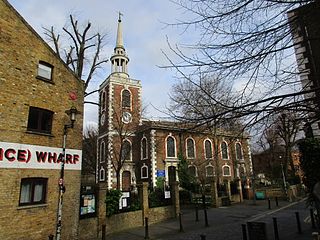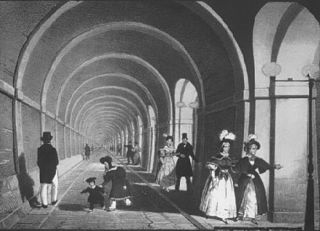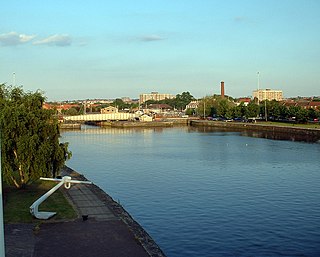
Sir Marc Isambard Brunel was a French-British engineer who is most famous for the work he did in Britain. He constructed the Thames Tunnel and was the father of Isambard Kingdom Brunel.

Rotherhithe is a district of South London, England, and part of the London Borough of Southwark. It is on a peninsula on the south bank of the Thames, facing Wapping, Shadwell and Limehouse on the north bank, with the Isle of Dogs to the east. It borders Bermondsey to the west and Deptford to the south-east. The district is a part of the Docklands area.

Box Tunnel passes through Box Hill on the Great Western Main Line (GWML) between Bath and Chippenham. The 1.83-mile (2.95 km) tunnel was the world's longest railway tunnel when it was completed in 1841.
Subterranean London refers to a number of subterranean structures that lie beneath London. The city has been occupied by humans for two millennia. Over time, the capital has acquired a vast number of these structures and spaces, often as a result of war and conflict.

Henry Maudslay was an English machine tool innovator, tool and die maker, and inventor. He is considered a founding father of machine tool technology. His inventions were an important foundation for the Industrial Revolution.

A tunnelling shield is a protective structure used during the excavation of large, human-made tunnels. When excavating through ground that is soft, liquid, or otherwise unstable, there is a potential health and safety hazard to workers and the project itself from falling materials or a cave-in. A tunnelling shield can be used as a temporary support structure. It is usually in place for the short-term from when the tunnel section is excavated until it can be lined with a permanent support structure. The permanent structure may be made up of, depending on the period, bricks, concrete, cast iron, or steel. Although modern shields are commonly cylindrical, the first "shield", designed by Marc Isambard Brunel, was actually a large, rectangular, scaffold-like iron structure with three levels and twelve sections per level, with a solid load-bearing top surface. The structure protected the men from cave-ins as they laboured within it, digging the tunnel out in front of the shield.

The Thames Tunnel is a tunnel beneath the River Thames in London, connecting Rotherhithe and Wapping. It measures 35 ft (11 m) wide by 20 ft (6.1 m) high and is 1,300 ft (400 m) long, running at a depth of 75 ft (23 m) below the river surface measured at high tide. It is the first tunnel known to have been constructed successfully underneath a navigable river. It was built between 1825 and 1843 by Marc Brunel, and his son, Isambard, using the tunnelling shield newly invented by the elder Brunel and Thomas Cochrane.

The Rotherhithe Tunnel, designated the A101, is a road tunnel under the River Thames in East London, connecting Limehouse in the London Borough of Tower Hamlets north of the river to Rotherhithe in the London Borough of Southwark south of the river. It was formally opened in 1908 by George, Prince of Wales, and Richard Robinson, Chairman of the London County Council. It is a rare example of a road tunnel where road traffic, pedestrians and cyclists all share the same tunnel bore. Transport for London took over ownership and maintenance of the tunnel in 2001.

The Tower Subway is a tunnel beneath the River Thames in central London, between Tower Hill on the north bank of the river and Vine Lane on the south. In 1869 a 1,340-foot-long (410 m) circular tunnel was dug through the London clay using a cast iron circular shield independently invented and built by James Henry Greathead, similar to an idea that had been not received a patent in 1864, nor built by Peter W. Barlow.

Wapping is a station on the London overground located on the northern bank of the River Thames in Wapping within the London Borough of Tower Hamlets. The station is served by National Rail London Overground services under the control of the London Rail division of Transport for London, however there is no standard red National Rail "double arrow" logo signage located at the station, instead only the Overground roundel. The station is between Shadwell and Rotherhithe, and is in Travelcard Zone 2.

Rotherhithe is a station on the East London Line located on the southern bank of the River Thames at Rotherhithe within the London Borough of Southwark, Greater London and is served by London Overground services. The station is between Wapping and Canada Water, and is in fare zone 2. The station re-opened for a preview service on 27 April 2010 to New Cross / New Cross Gate and 23 May 2010 for full service to New Cross / West Croydon / Crystal Palace. On 9 December 2012, the line was extended to serve Clapham Junction via Peckham Rye.

King William Street was the original but short-lived northern terminus of the City and South London Railway (C&SLR), the first successful deep-level underground railway in London and one of the component parts of the London Underground's Northern line. It was located in the City of London, on King William Street, just south of the present Monument station. When King William Street was in operation the next station to the south was Borough and the southern terminus of the line was Stockwell.
The year 1843 in architecture involved some significant events.

The Portsmouth Block Mills form part of the Portsmouth Dockyard at Portsmouth, Hampshire, England, and were built during the Napoleonic Wars to supply the British Royal Navy with pulley blocks. They started the age of mass-production using all-metal machine tools, and are regarded as one of the seminal buildings of the British Industrial Revolution. They are also the site of the first stationary steam engines used by the Admiralty.

Isambard Kingdom Brunel was a British civil engineer and mechanical engineer who is considered "one of the most ingenious and prolific figures in engineering history", "one of the 19th-century engineering giants", and "one of the greatest figures of the Industrial Revolution, [who] changed the face of the English landscape with his groundbreaking designs and ingenious constructions". Brunel built dockyards, the Great Western Railway (GWR), a series of steamships including the first purpose-built transatlantic steamship, and numerous important bridges and tunnels. His designs revolutionised public transport and modern engineering.

Windsor Railway Bridge is a wrought iron 'bow and string' bridge in Windsor, Berkshire, crossing the River Thames on the reach between Romney Lock and Boveney Lock. It carries the branch line between Slough and Windsor.

The Cumberland Basin is the main entrance to the docks of the city of Bristol, England. It separates the areas of Hotwells from the tip of Spike Island.
The Thames Archway Company was a company formed in 1805 to build the first tunnel under the Thames river in London.
William Gravatt FRS, was a noted English civil engineer and scientific instrument maker.

Michael Lane was a British civil engineer who served as the Chief Engineer of the Great Western Railway (GWR). A protégé of Isambard Kingdom Brunel, he worked with both Brunel and Brunel's father Marc on various projects before joining the younger Brunel on the GWR. He eventually succeeded that Brunel as the railway's Chief Engineer, serving in the position for nearly eight years before his death.






















